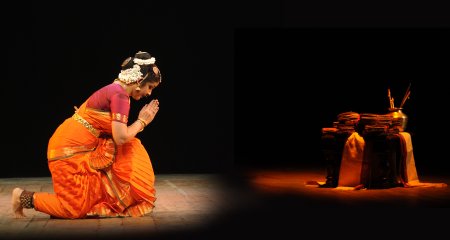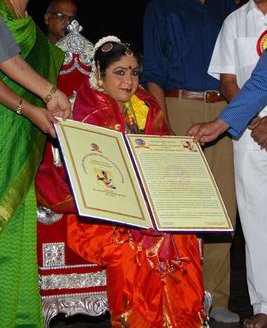 |
 |
Scintillating
performance by Ananda Shankar Jayant December 9, 2010 Annamayya, the pioneer of Padakavita in Telugu, stands tall on many a count. Imbued with diverse strands of thought and expression in superlative poetic charms, his works remain a challenge for any to delve deep into his idiom. Noted dancer Ananda Shankar Jayant, who revels in taking up challenging projects, conceived a unique dance feature 'Taala Patra Hymns from the Hills' based on the compositions of Annamayya and as is her wont, came out in flying colours.  It was like a cruise to the shores of devotional ecstasy and spiritual serenity via Annamayya's compositions in the kinetic phraseology of Bharatanatyam as Ananda Shankar Jayant danced her way into the hearts of dance aficionados at Kalabharati in Visakhapatnam on November 28, 2010. With all the trappings of a full length ballet, it was truly an aesthetic capsule of varied aspects of the theme in four suites.
Ananda's artistic acumen lay in her remarkable prowess that captured rich and varied aspects of the chosen piece in all its profundity. Her eye for detail was extraordinary, which lent a distinct edge to her expressional élan. The way she explored a wide range of emotions from devotion to romance and pathos to supplication reflected her command over abhinaya. The uncanny artistic ability she displayed in transitions from one mood to another stupefied the audience. In delineation of varied aspects of the compositions such as episodes from Ramayana or that of the childhood pranks of Lord Krishna besides ferocious facets of Narasimha Swamy of Ahobilam and shades of divine romance, her coalescence of expression and footwork was amazing. While her adoption of an iconographic format in presentation of Ahobila Narasimha Swamy ensured an indelible impression on the minds of the viewers, her elaboration of Alarulukuriyaga - tuned by legendary Rallapalli Anantakrishna Sarma in raga Shankarabharanam - in kinetic idiom was simply superb. The composition, a quintessence of a mantra in Lakshmi Hridyam Sthotra, unveils Goddess Alamelumanga in a danseuse mode. Ananda was astute enough to grasp the inherent dance aspects in this seemingly plain piece of romantic import. She has not just executed the technical aspects of dance imbedded in the compositions such as pirouettes in quick succession, but also opted for - different from the usual dance costumes - a pavada-davani outfit, truly symbolic of a bubbly belle in all its traditional aura and that lent an edge to the presentation. Another number Ettunerichitivayya, which opens on a warm note of emotional nearness bordering on first name terms, sparkled in both abhinaya and footwork. Ananda's depiction of emotional closeness between deity and devotee in a wide range of sanchari bhavas testified her in depth grasp of the lyrical nuances. She was a boneless wonder in execution of intricate footwork tapping an array of bubbly rhythms in all its kinetic splendour with a photo finish in sculpturesque postures. That she was an ace choreographer was evident in every frame. Though a solo feature, her elegance in kinetic movements ensured the effect of a total ballet. Nattuvangam and jathi composition by IV Renuka Prasad, musical score by S Venu Madhav were an asset, while TP Balasubramaniam on mridangam, Sai Kumar on violin, Uma Venkateswarulu on flute lent commendable orchestral support.  Velcheti Subrahmanyam has been with the New Indian Express for over twenty years contributing reviews and articles on the cultural front. |